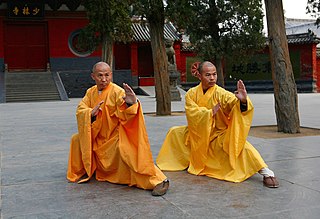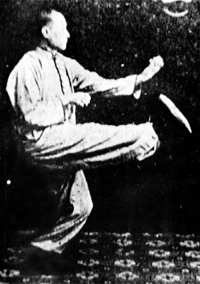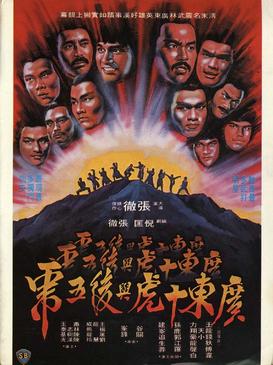
Shaolin kung fu, also called Shaolin Wushu, or Shaolin quan, is the largest and most famous style of kung fu. It combines Chan philosophy and martial arts. It was developed in the Shaolin Temple in Henan, China during its 1500-year history. In Chinese folklore there is a saying, "Shaolin kung fu is the best under heaven," which indicates its superiority among martial arts, and "All martial arts under heaven originated from Shaolin," which indicates its influence on other martial arts. The name Shaolin is also used as a brand for the external styles of kung fu. Many styles in southern and northern China use the name Shaolin.

Hung Ga Kuen (Cantonese) or Hongjiaquan (Mandarin) - alternatively shortened as either Hung Ga (洪家) or Hung Kuen (洪拳) - is an ancient southern Chinese martial art, which roots lie in the Northern Shaolin kung fu. During the turn of the 3rd millennium, Hung Ga was one of the most widely practiced styles of kung fu from southern China in the world.

Eagle Claw is a style of Chinese martial arts known for its gripping techniques, system of joint locks, takedowns, and pressure point strikes, which is representative of Chinese grappling known as Chin Na. The style is normally attributed to the famous patriotic Song dynasty General Yue Fei. Popular legends states that he learned martial arts from a Wudang Monk named Zhou Tong and later created Eagle Claw to help his armies combat the invading armies of the Jin dynasty. It was passed down until the Ming dynasty. Thus, the style took on long range strikes and aerial jumps. During the Qing dynasty, the military instructor Liu Shi Jun became known as the modern progenitor of Eagle Claw and taught many students. His student Liu Cheng You later taught Chen Zizheng who was invited to teach the style in the prestigious Chin Woo Athletic Association during the Republican era. The style spread as Chin Woo opened sister schools in other provinces. Today, it is practiced around the world.

Northern Praying Mantis is a style of Chinese martial arts, sometimes called Shandong Praying Mantis after its province of origin. It is one of the best known styles of "Northern" kung fu and it encompasses of many styles, with the three main ones being the six-harmony style, eight-steps style and seven-star style.

Wong Kei-ying or Huang Qiying was a Chinese Hung Ga martial artist and physician of Cantonese ethnicity, who lived during the Qing dynasty. He was one of the Ten Tigers of Canton and was best known for his use of the Tiger Crane Paired Form Fist skill set. His son, Wong Fei-hung, who inherited his martial arts and medical skills, is commonly portrayed as a folk hero in Chinese popular culture.

In its broadest sense, Northern Shaolin is the external martial arts of Northern China, referring to those styles from the Northern Shaolin Monastery in Henan and specifically to the style practice by Gù Rǔzhāng, the Sōngshān Shí Lù Shàolínquán (嵩山十路少林拳) / Song Mountain Ten Road Shaolin Boxing.

Nanquan refers to a classification of Chinese martial arts that originated in Southern China.

Meihuaquan is a common term used to name styles or exercise sets of kung fu:

Jow Ga kung fu is a form of Chinese martial art. It was founded by Jow Lung who was born in 1891, on the eleventh day of the third lunar month in Sa Fu Village of the Guangdong province, and died in 1919. His father was Jow Fong Hoy and his mother’s maiden name was Li. At the time of its inception, this particular style of kung fu was labeled as having the head of Hung Gar, the tail of Choy Gar and the patterns of the tiger and leopard, or simply Hung Tao Choy Mei. It was so labeled because the essential techniques incorporated the muscular and mighty movements of Hung Gar and the swift footwork and complex kicking of Choy Gar, making it a very effective form of self defense with emphasis on simultaneous attack and defense.

Lam Sai-wing was a Hung Gar martial artist. He was a student of the Chinese martial artist, acupuncturist, and folk hero of Cantonese ethnicity, Wong Fei-hung.

Fut Ga Kuen or Buddhist Family Fist is a relatively modern Southern Shaolin style of Kung Fu devised primarily from the combination of Hung Ga Kuen 洪家 and Choy Gar 蔡家 Kuen. The style utilizes mostly punches, palm strikes and low kicks, further characterized by evasive footwork, circular blocks and using the opponent's force against them.

Ten Tigers from Kwangtung is a 1980 Hong Kong martial arts film directed by Chang Cheh and produced by Mona Fong. It is one of Chang Cheh's tales of Shaolin's historic rivalries with the Qing dynasty and the Canton Tigers. Along with the Brave Archer series, Ten Tigers had an all-star cast of Shaw martial artists.

Choy Gar, also Caijia Quan, is a Chinese martial art deriving its name from the Cantonese-born founder, Choy Gau Lee (蔡九儀), and is one of the five main family styles of Kung Fu in Southern China. It was taught to him by a monk named Yi Guan. This style, founded in the 17th century, is a combination of rat and snake styles emphasizing on swift footwork and rapid strikes.
So Chan, also known by his nickname Beggar So, was a Chinese martial artist and folk hero who lived during the late Qing dynasty. One of the Ten Tigers of Canton, he was best known for his drunken boxing.

Choy Lee Fut is a Chinese martial art and wushu style, founded in 1836 by Chan Heung (陳享). Choy Li Fut was named to honor the Buddhist monk Choy Fook who taught him Choy Gar, and Li Yau-san (李友山) who taught him Li Gar, plus his uncle Chan Yuen-wu (陳遠護), who taught him Hung Kuen, and developed to honor the Buddha and the Shaolin roots of the system.
Hak Fu Mun 黑虎門 is a southern style of Chinese Kung Fu originating from the Shaolin Temple. The style's founder was So Hak-fu, who was one of the famed Ten Tigers of Canton 廣東十虎. The style was opened to the public by Wong Cheung 黃祥 who expanded the system.
Chan Kowk-wai was born on 3 April 1936, in Taishan in the province of Guangdong, China. He introduced traditional Shaolin kung fu to Brazil through the China-Brazil Kung Fu Academy. His disciples have spread as far as the USA, Canada, Spain, Argentina, Chile and the Czech Republic.

Lam Cho was the Hung Ga Grandmaster and Dit Da practitioner of the Lam Family Hung Ga lineage. He was noted to be the last martial arts Grandmaster who lived during the times of well-known martial artists Wong Fei-hung and Lam Sai-wing, his adoptive uncle.
Tibetan White Crane, also known in Cantonese as Bak Hok Pai, is a Chinese martial art with origins in 15th-century Tibetan culture that has developed deep roots in southern China. Tibetan White Crane became so established in Guangdong, Hong Kong and Macau by the twentieth century that it was accepted as a local martial art in that region. From there it has spread around the world.









